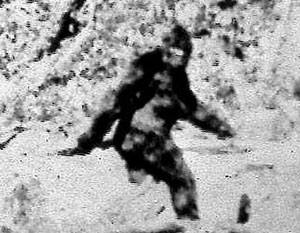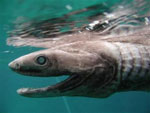Bigfoot “discovery” looks to be a hoax
Bigfoot “discovery” looks to be a hoax
mongabay.com
August 18, 2008
|
|
A much-hyped press conference claiming to present evidence of the existence of Bigfoot offered little in the way of proof but a lot of shameless self-promotion by the “discoverers”.
Addressing the media Friday afternoon at a hotel in Palo Alto, California, Matthew Whitton, Rick Dyer, and Tom Biscardi showed reporters two blurry photos of what looked like a Sasquatch Halloween costume in a freezer, an out-of-focus picture of a chewbacca-like figure in the woods, and an email from an entomologist saying the DNA samples were “inconclusive”, but at least a 96 percent match with a possum.
|
|
“What I’ve seen so far is not compelling in the least, and I think the pictures cast grave doubts on their claim,” Jeffrey Meldrum, a Bigfoot researcher and a professor at Idaho State University, told Scientific American. “It just looks like a costume with some fake guts thrown on top for effect.”
Media reports indicate that the men have presented at least two different accounts of how they discovered the creature in the backwoods of Georgia. They have refused to give the specific location fearing that it is an endangered species, although a company run by Dyer and Whitton may offer bigfoot sighting tours in the future.
“There’s a lot of comment being made that it looks fake, or it looks like a suit,” said Dyer. “But these people wasn’t there when I was sweating, pulling this thing through the woods.”
Biscardi, who has been associated with Bigfoot hoaxes in the past, also used the opportunity to plug his host Internet radio show about Bigfoot.
The promotional effort—which included a widely distributed press release prominently mentioning the name of a PR agency—raised suspicions that the whole thing was little more than a marketing ploy by the men.
 A still from the famous 1967 Bigfoot film, which may or may not show a man in a gorilla suit. Courtesy of the AP. |
“I’ve had interactions with Tom Biscardi in the past, and based on that history, I would say that anything he is involved in is suspect,” Meldrum told Scientific American. “The fact that the two Georgian men turned to him and not anyone with scientific credentials is very questionable.”
U.S. Fish and Wildlife Reserve spokesman Tom Mackenzie told the Associated Press (AP) his agency would not waste time or resources investigating the claims.
“It’s not on endangered species on any list that we’ve got,” Mackenzie was quoted as saying.
Related
Chupacubra is actually a hairless coyote
(11/2/2007) DNA analysis has identified the creature discovered on a Texas ranch as nothing more than a coyote, according to the Associated Press. The animal may have had mange or another sickness or disorder.
Chupacabra story is a hoax; likely a Xolo dog breed
(9/4/2007) An alleged chupacabra carcass found in Texas is likely a hoax to sell T-shirts say dog experts. The animal, described in an Associated Press report last week as “a cross between two or three different things”, was found as road kill last month near the Texas town of Cuero. The woman who discovered the carcass has been using it to market chupacabra T-shirts. In lively Internet discussions dog breeders say the carcass appears to be a Xoloitzcuintle or Xolo, otherwise known as a Mexican Hairless dog, rather than the blood-sucking creature of legend.
 |
World’s only blue lizard heads toward extinction
(3/7/2007) High above the forest floor on the remote Colombian island of Gorgona lives a lizard with brilliant blue skin, rivaling the color of the sky. Anolis gorgonae, or the blue anole, is a species so elusive and rare, that scientists have been unable to give even an estimate of its population. Due to the lizard&spod;s isolated habitat and reclusive habits, researchers know little about the blue anole, but are captivated by its stunning coloration.
 |
Unusual prehistoric shark beast captured in Japan
(1/24/2007) A rare frilled shark was captured live by fishermen off the coast of Japan. The toothy eel-like creature was taken to Awashima Marine Park in Shizuoka where it later died according to Reuters.
In search of Bigfoot, scientists may uncover unknown biodiversity in Malaysia
(2/1/2006) Malaysian scientists are scouring the rainforests of Johor state in search of the legendary ape-man Bigfoot, supposedly sighted late last year. But they are more likely to encounter some less fantastic but unique creatures that dwell in these still unexplored ecosystems.
Sex vs. Intelligence: Bigger balls mean smaller brain
(12/13/2005) In a recent study of bats, Scott Pitnick, professor of biology at Syracuse University, found that testis size is negatively correlated with brain size. In other words, the bigger the balls of a bat species, the smaller its brain.
Scientists search for Mongolian Death Worm
(5/3/2005) A group of English scientists are spending a month in the Gobi desert in search of the Mongolian Death Worm, a fabled creature said to lurk in the sands of the hostile region. The three to five feet long long creature is known to the locals as Allghoi khorkhoi, Mongolian for intestine worm because it is reported to look like the intestine of a cow. Mongolian nomads have made extraordinary claims about the animal, reporting that the death worm can spit a corrosive yellow saliva that acts like acid and that they have the ability to generate blasts of electricity powerful enough to kill a full grown camel.

